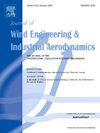带附加挡板的摆式 TMD 振动控制性能及其在高层建筑中的应用研究
IF 4.2
2区 工程技术
Q1 ENGINEERING, CIVIL
Journal of Wind Engineering and Industrial Aerodynamics
Pub Date : 2024-10-15
DOI:10.1016/j.jweia.2024.105926
引用次数: 0
摘要
尽管摆锤调谐质量阻尼器(PTMD)是最经典、最常用的振动控制装置之一,但由于其线性 TMD 的自然特征,它具有明显的局限性。研究人员提出并引入了摆弦(PTMD-AS)的附加阻尼器,以通过触发其非线性来改善 PTMD 的性能。建立了一个 2-DOF 模型来分析系统在谐波激励下的动态响应,并使用拉格朗日方程制定了控制方程。利用扩展增量谐波平衡 (EIHB) 法和 Runge-Kutta (R-K) 法计算了系统的频率响应和时间历程。详细探讨了具有刚度硬化的摆的非线性动态特性。进行了灵敏度分析,以研究挡块位置的影响。结果发现,当摆锤在通过附加挡块时发生明显的刚度硬化,可能会诱发非周期性响应或多重解。最后,在风洞实验的基础上,通过对受到随机风激励的高层建筑进行数值模拟,证明了 PTMD-AS 的有效性和稳健性。本文章由计算机程序翻译,如有差异,请以英文原文为准。
Study on vibration control performance of pendulum TMD with additional stoppers and its application on high-rise buildings
Although pendulum tuned mass damper (PTMD) is one of the most classic and commonly used vibration control devices, it has clear limitation due to the natural feature of linear TMD. Additional stoppers for the pendulum string (PTMD-AS) were proposed and introduced to improve the PTMD's performance by triggering its nonlinearity. A 2-DOF model was established to analyze the dynamic response of the system subjected to harmonic excitation, and the governing equations were formulated using the Lagrange equation. The extended incremental harmonic balance (EIHB) method and the Runge-Kutta (R-K) method were utilized to calculate the frequency response and time history of the system. Nonlinear dynamic characteristics of the pendulum with stiffness hardening were explored in detail. Sensitivity analyses were performed to investigate the effect of stopper position. It was found that aperiodic responses or multiple solutions could be induced when the pendulum underwent significant stiffness hardening upon passing the additional stoppers. Finally, the effectiveness and robustness of PTMD-AS are demonstrated in a numerical simulation of a high-rise building subjected to random wind excitation based on wind tunnel experiments.
求助全文
通过发布文献求助,成功后即可免费获取论文全文。
去求助
来源期刊
CiteScore
8.90
自引率
22.90%
发文量
306
审稿时长
4.4 months
期刊介绍:
The objective of the journal is to provide a means for the publication and interchange of information, on an international basis, on all those aspects of wind engineering that are included in the activities of the International Association for Wind Engineering http://www.iawe.org/. These are: social and economic impact of wind effects; wind characteristics and structure, local wind environments, wind loads and structural response, diffusion, pollutant dispersion and matter transport, wind effects on building heat loss and ventilation, wind effects on transport systems, aerodynamic aspects of wind energy generation, and codification of wind effects.
Papers on these subjects describing full-scale measurements, wind-tunnel simulation studies, computational or theoretical methods are published, as well as papers dealing with the development of techniques and apparatus for wind engineering experiments.

 求助内容:
求助内容: 应助结果提醒方式:
应助结果提醒方式:


